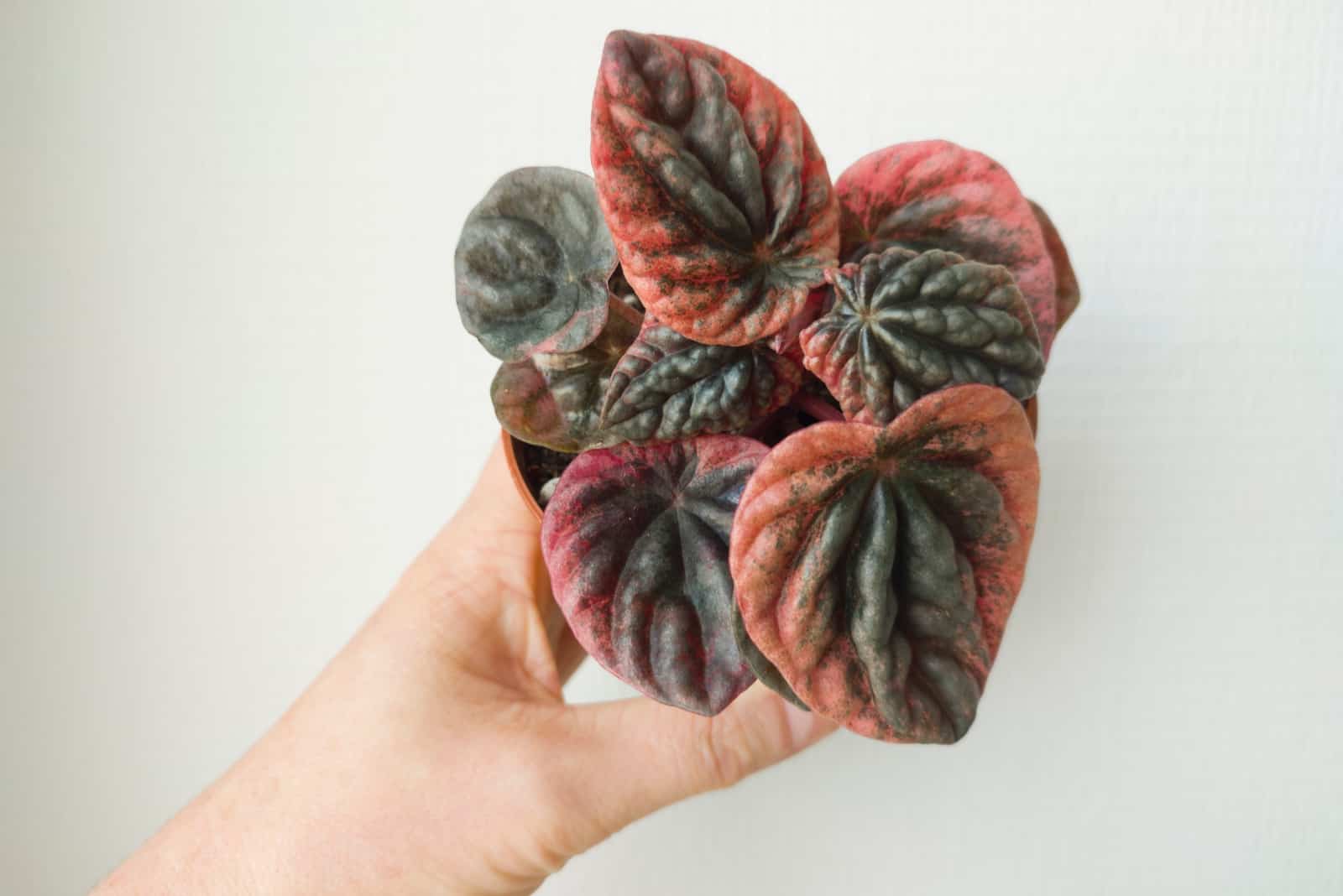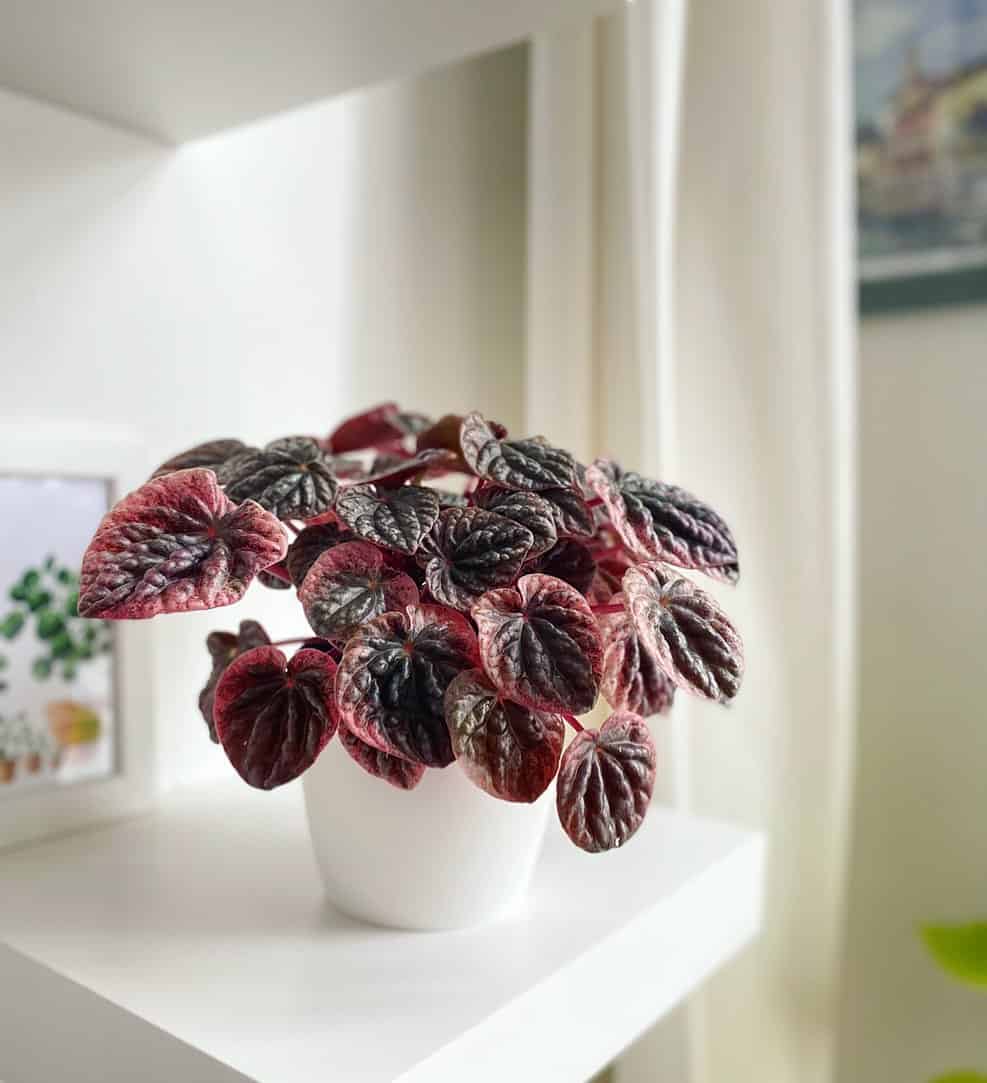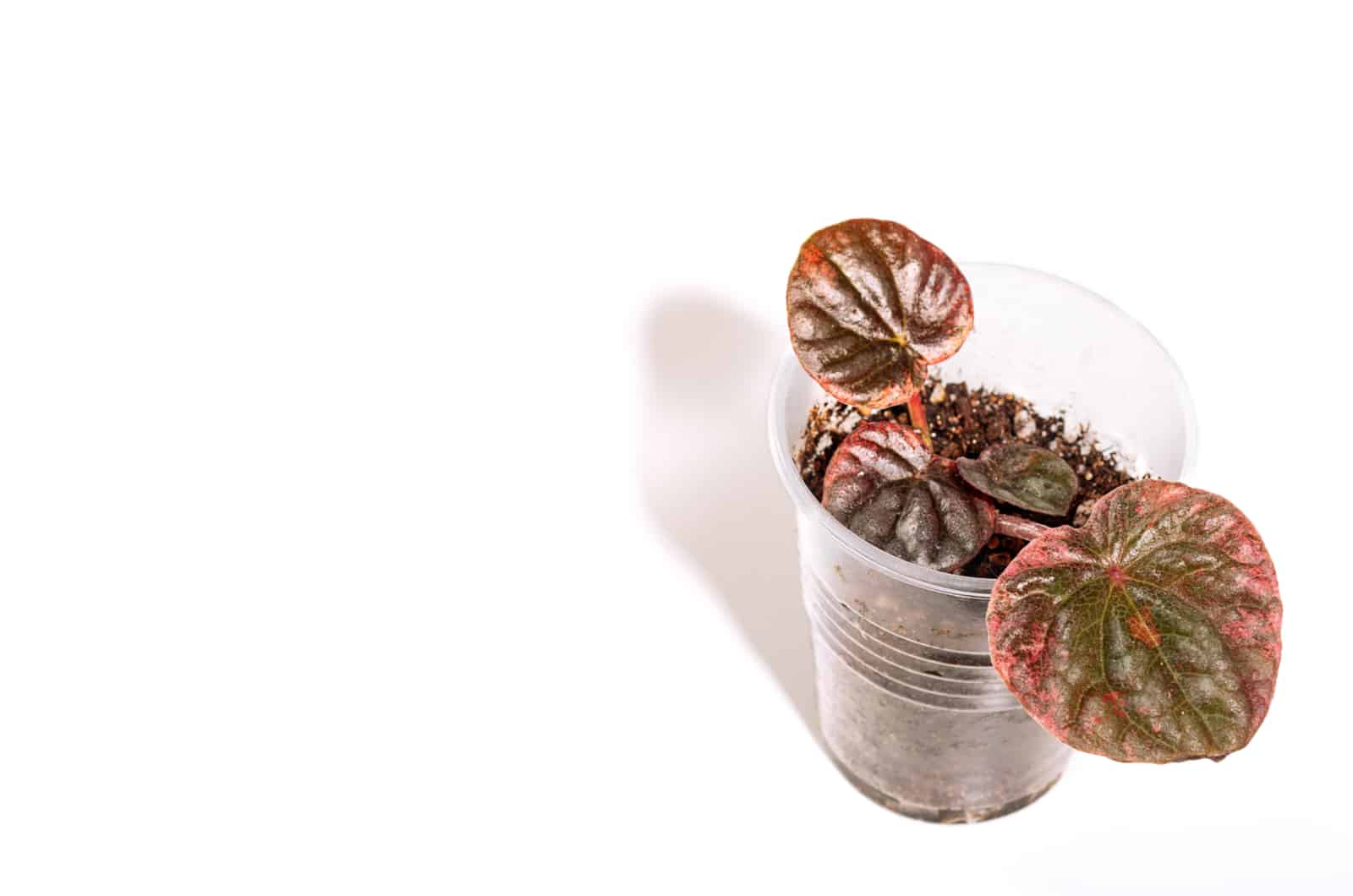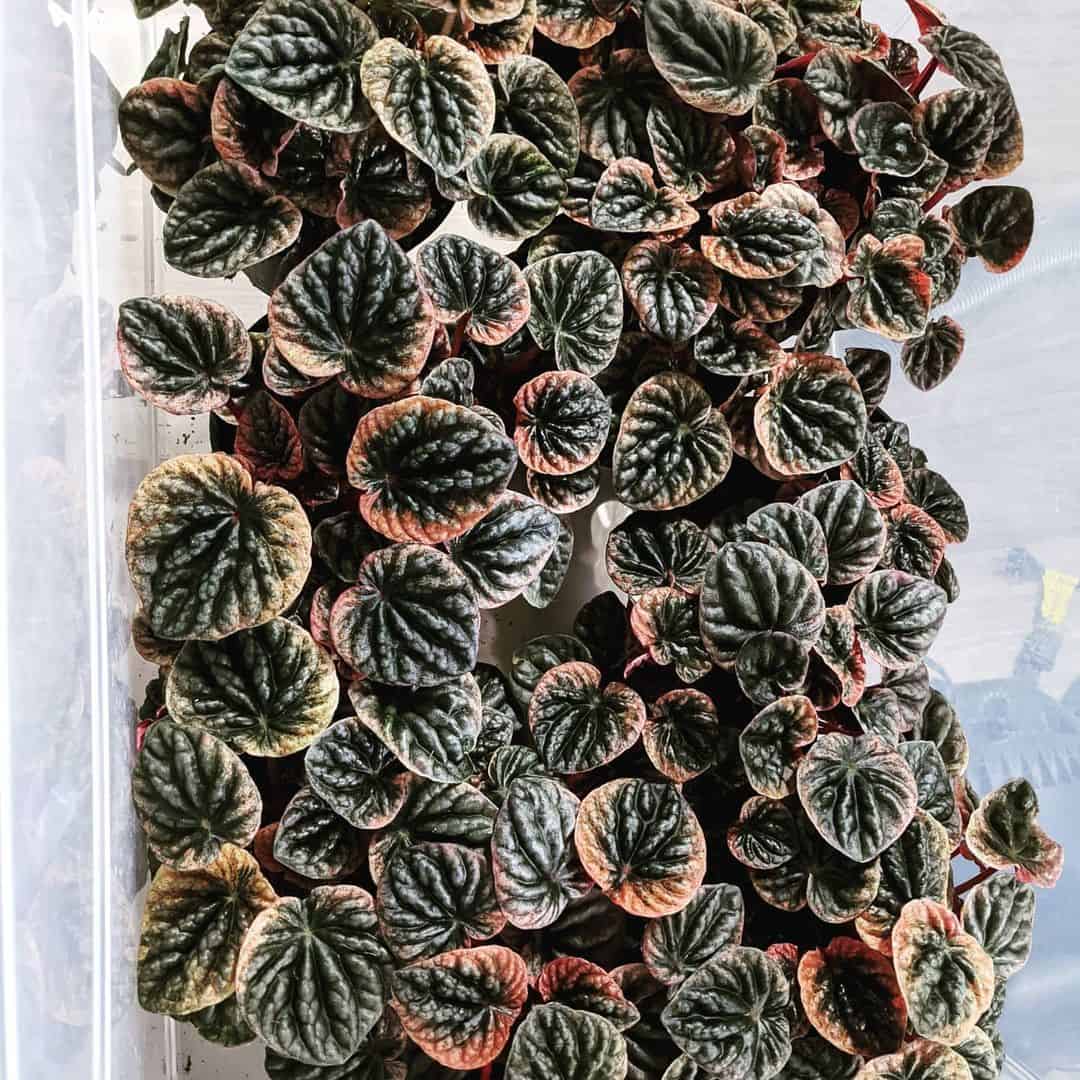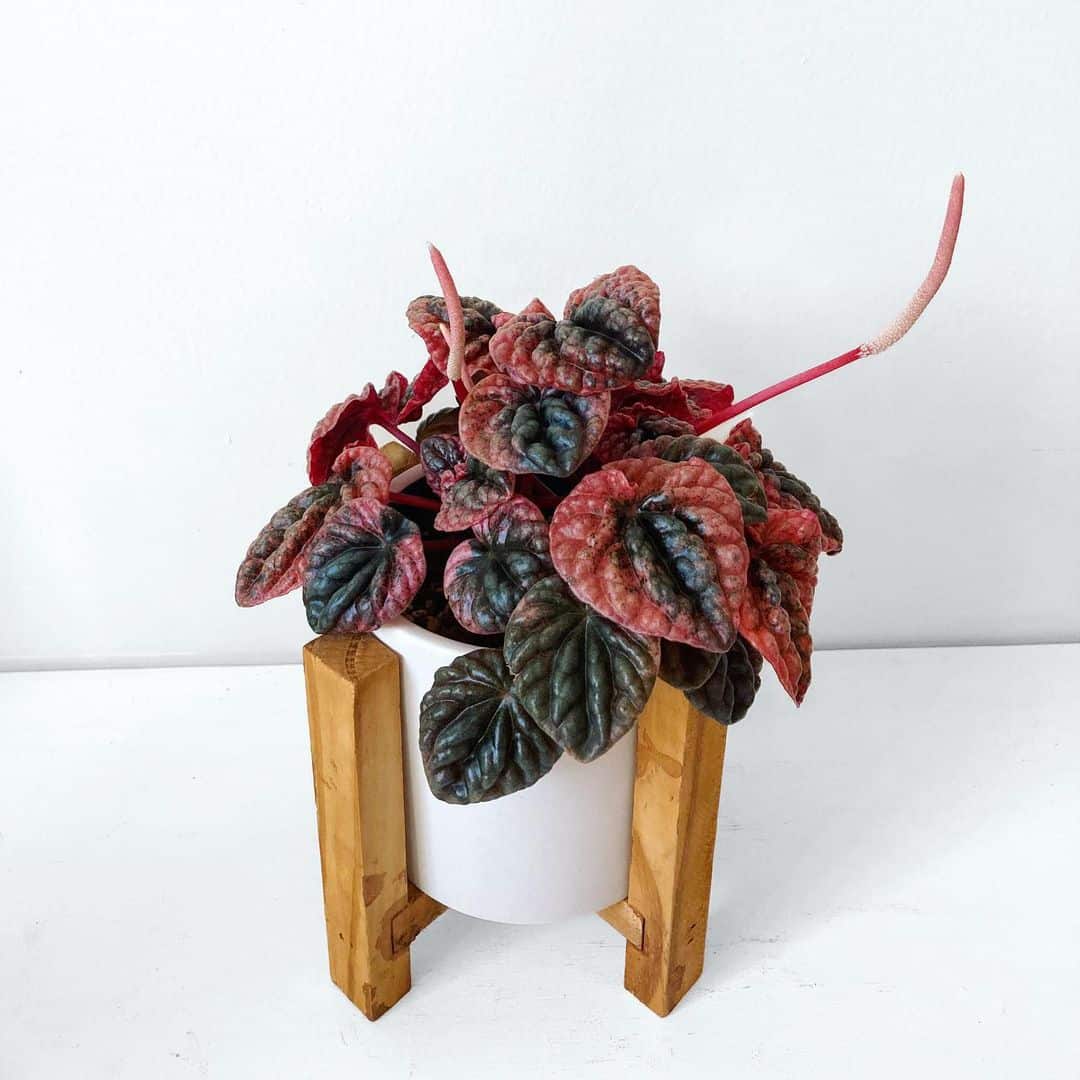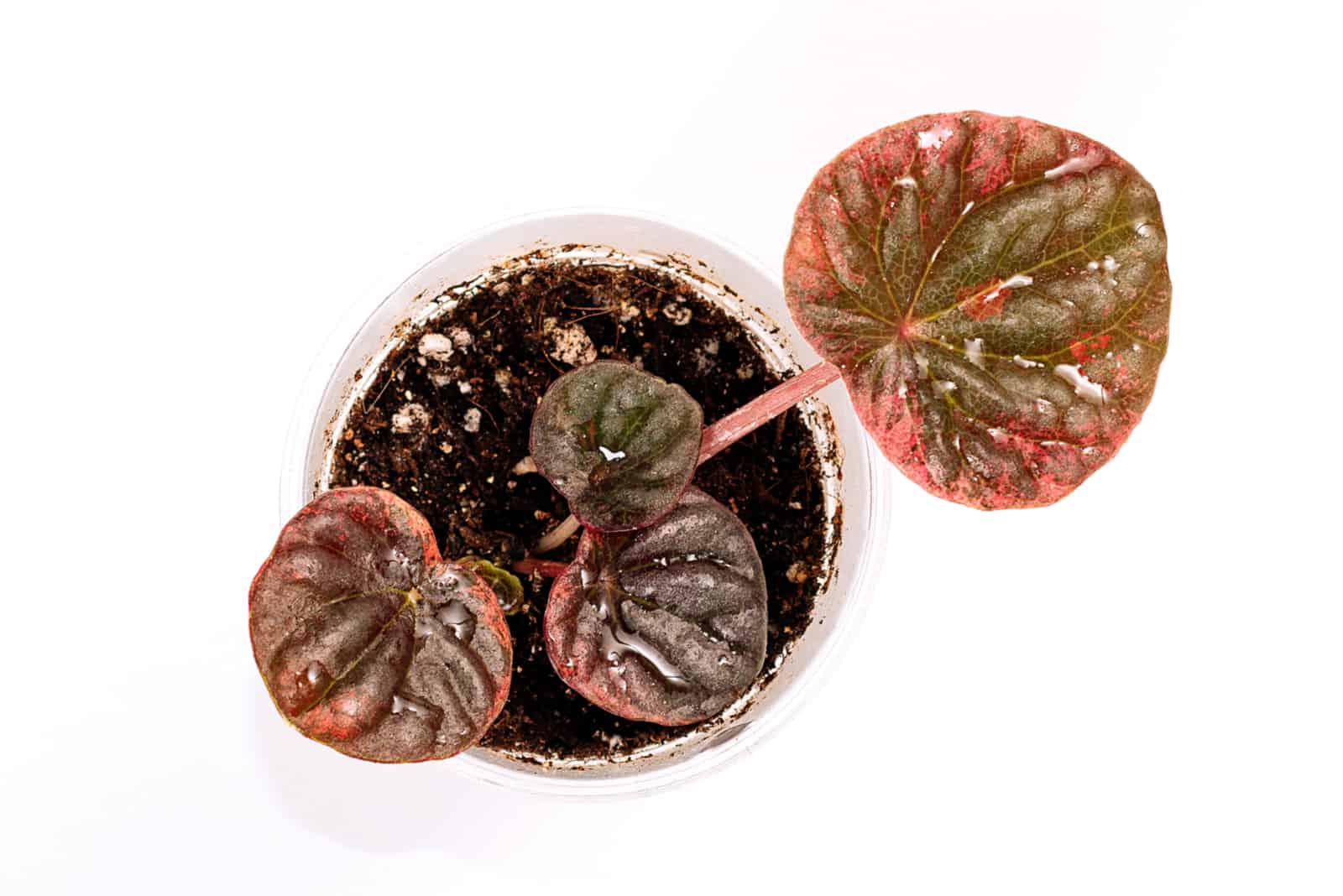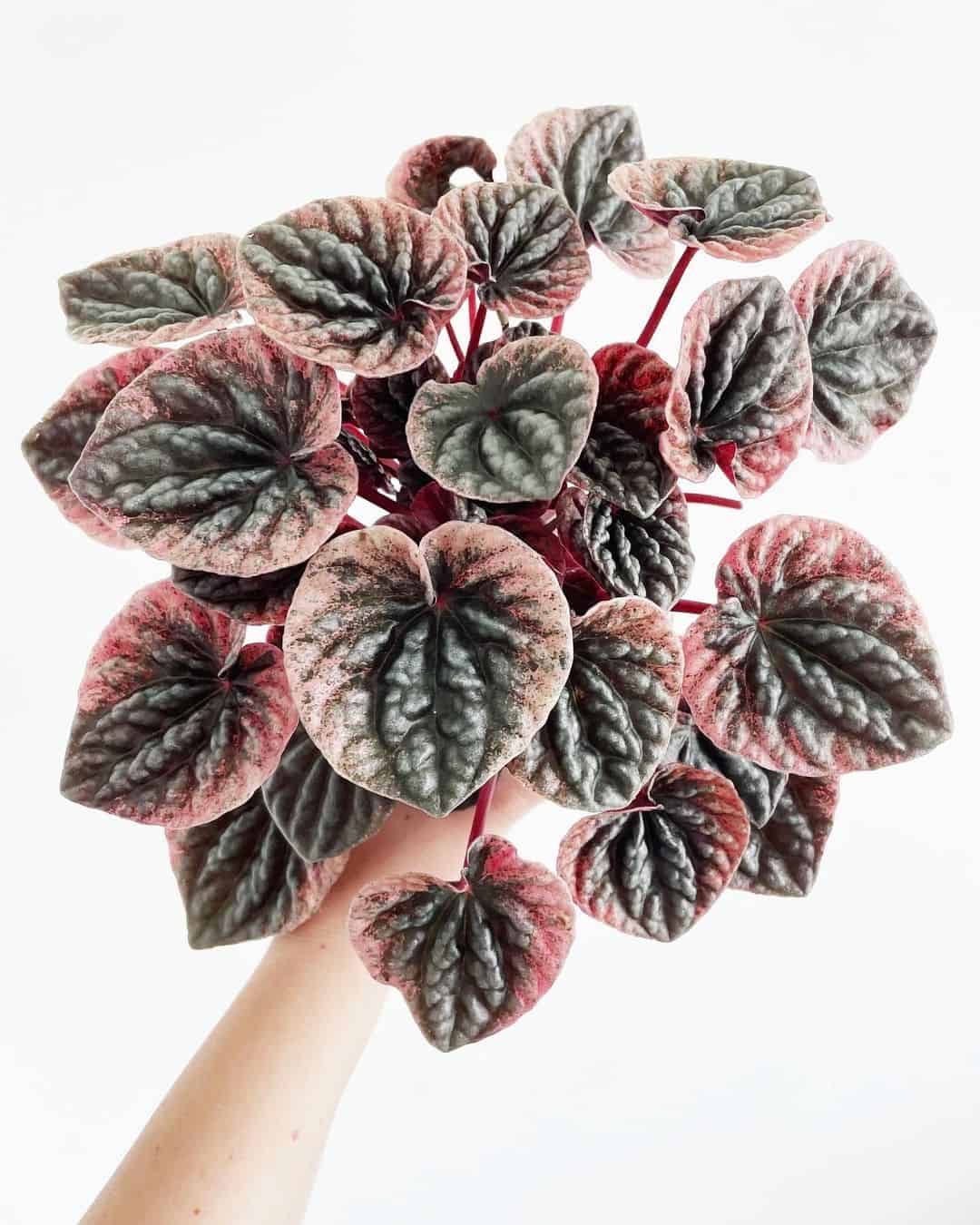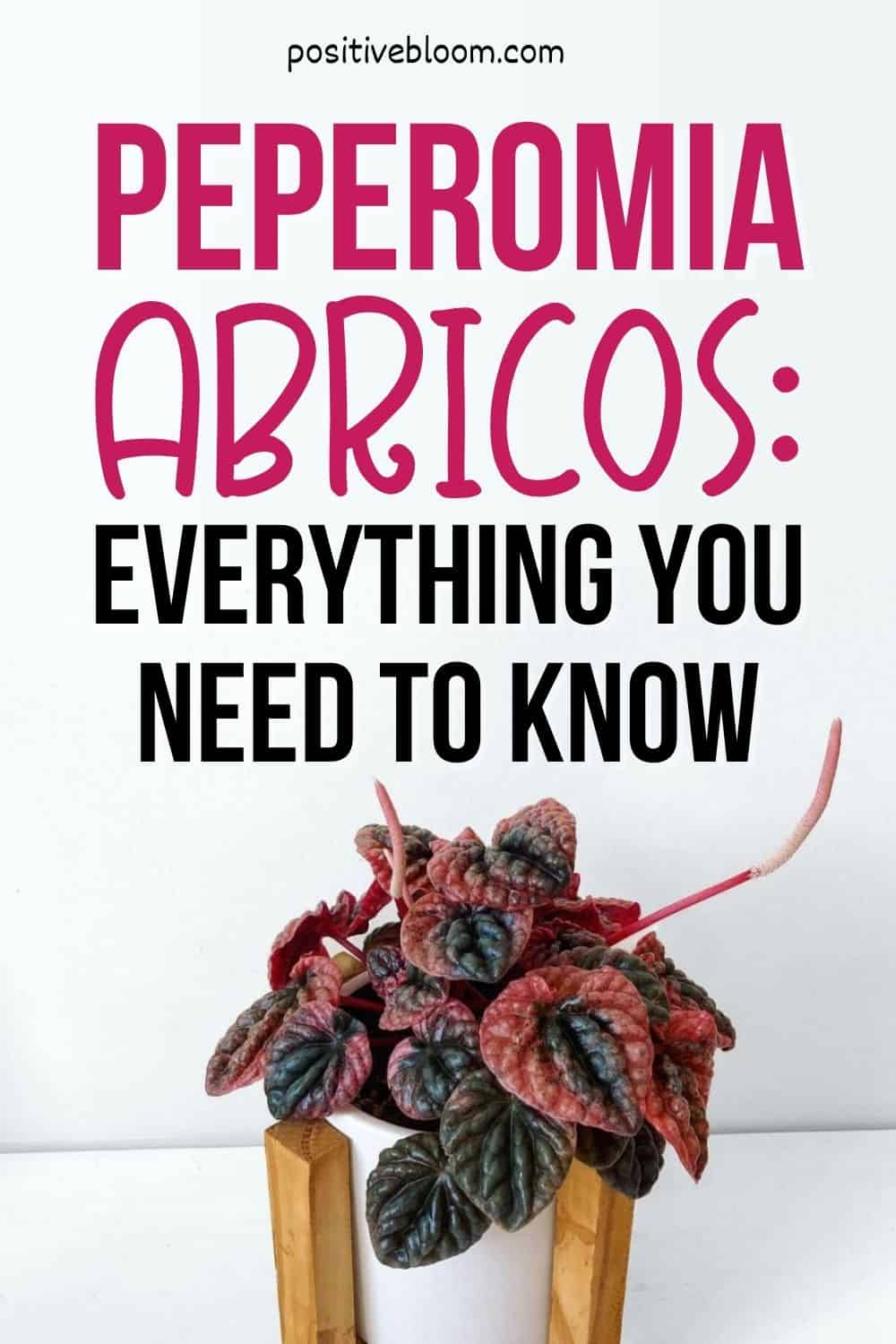We all need something to cheer us up on a rainy day, and that’s where Peperomia Abricos comes into play.
It has that effect that instantly relaxes all of your muscles, and your anxiety is gone before you can snap your fingers.
Here are the general specifics about this Peperomia:
| Scientific name: | Peperomia caperata ‘Abricos’ |
| Native habitat: | Northern America |
| Growth rate: | slow grower |
| Size: | approximately 1 foot (30 cm) tall |
| Type: | perennial |
| Toxicity: | non-toxic |
This fascinating plant is perfect for beginner gardeners as it doesn’t require much of your attention.
This article brings you all the requirements you need to meet in order to have a healthy plant. You will also learn about the most common issues that affect this plant, so you’ll know how to prevent them and cure them if it ever comes to that.
And of course, we have to tell you about its unique foliage that leaves everyone breathless!
Let’s start!
The Peperomia Abricos Care Guide
Photo from: @mamhy_plants
The Peperomia Abricos is a low-maintenance plant that’s perfect for your office or reading room.
It will transform the look of your workspace and give you an escape that we all sometimes need.
It doesn’t require much work; you only need to make sure that your Peperomia plant gets plenty of filtered light, a bit of water, and that the soil is well-draining and never wet.
This is basically all you need to do; however, if you want to know the exact numbers and quantities, you might want to check out the section below.
Light Requirements
This Peperomia variety can thrive in spaces that receive medium to bright indirect light.
It can tolerate low-light levels, but its amazing foliage would pale in color, and you’d be left to wonder why you bought it in the first place.
However, you shouldn’t expose it to direct sunlight either, as this may lead to severe sunburn.
A north-facing room is not an option since it doesn’t get enough light, but you can place this plant in an east-, west-, or south-facing room and enjoy its unique color.
Just make sure you don’t put it on a windowsill or directly in front of a window, as the sun can damage its leaves. Move it at least 3 feet (90 cm) away from a south-facing window, preferably on a flower shelf next to your Alocasia or Pilea.
Water And Humidity Requirements
The Peperomia Abricos is a plant that won’t punish you for your neglect; in fact, it will even benefit from scarce watering.
It stores water in its fleshy leaves, so you don’t need to water it very often. The main rule is to check the topsoil before watering; if it isn’t dry, don’t water the plant!
Watering in summer and winter differs because this plant enters dormancy in winter, so it needs less water.
You might need to water this plant more than once a week if the temperatures are exceptionally high in the summertime.
However, you should always check the topsoil because that is the only way to avoid overwatering, which would eventually lead to root rot.
Humidity
This type of Peperomia plant loves moderate humidity levels and will thrive best when the humidity is around 40-50%,
However, the average humidity of our homes is usually lower than this, so we need to find creative ways to increase it.
We bring you our 4 favorite ways of maintaining moderate humidity levels:
1. Put the plant in the bathroom. Bathrooms are the most humid rooms in our flats and houses, which you can decorate with this Peperomia, and they also have enough light and moisture to keep your plant happy for many years.
2. The pebble tray method. We love pebble trays and how they fit every decor, especially the rustic decor of cottage houses.
You simply need to find a deep tray that you can fill with small rocks or pebbles and water. Put the potted plant on top of it, and that’s it. The water will evaporate and raise the humidity level around your plant.
3. Humidifier. If you want to keep your plant in a living room or reading room and the pebble tray simply doesn’t fit the decor, you can always invest in a small humidifier that will do all the work.
4. Misting. The last method of raising the humidity level is misting the plant’s leaves from time to time. However, this method is somewhat risky, and you have to be very careful with it.
Spraying the foliage with water too often may lead to fungal infections. You should always wait until the foliage is completely dry before misting.
Remember, lower humidity levels won’t kill your plant, but constantly wet foliage might!
Temperature
The Peperomia Abricos loves warmth and thrives in temperatures between 65 and 80 °F (18-27 °C).
You need to shelter it when the temperatures drop below 55 °F (13 °C), so growing it in a terrarium is our favorite option.
Also, we’ve had many concerned friends who were afraid to order plants online during winter, but you don’t have to worry about that. They come with heat packs and are well-protected.
Furthermore, you need to make sure that these plants are safe from the summer heat, and one way to do this is by keeping them in well-ventilated rooms.
However, you should avoid drafts and sudden temperature changes, so don’t keep them below the AC.
Soil And Fertilizer
Peperomias prefer slightly acidic substrates with a pH level between 6.0 and 6.6. This indoor plant also requires a fast-draining medium that will help prevent root rot.
You can use an orchid mix or make your own potting mix. Use potting soil enriched with peat moss as a base and add plenty of perlite and vermiculite, these help with aeration and water retention.
Peat moss retains moisture and releases it when the plant actually needs it, so your Peperomia won’t suffocate in water.
Also, the soil needs to be rich in nutrients and organic matter, and if you meet all these requirements, you won’t have to fertilize your plant at all.
However, if your soil is poor in nutrients, you can occasionally fertilize your plant, but there are some rules you need to follow to avoid over-fertilization.
Fertilizer
The 3 main elements that plants need for vegetative growth, flower and fruit production are nitrogen, phosphorus, and potassium. The Peperomia Abricos also needs these nutrients, and if there aren’t enough of them in the soil, you‘ll need to use fertilizers.
This Peperomia prefers well-balanced, diluted, liquid fertilizer, such as 14-14-14. However, you have to know what triple 14 fertilizer is and how it’s used, in order not to burn your plants.
Also, don’t forget to water the plant thoroughly before fertilizing it, as this reduces the risk of over-fertilization and salt build-up.
Finally, if you repot your Peperomia often, you don’t have to use fertilizers as it will have all the necessary nutrients in the soil.
When To Repot The Peperomia Abricos
The general rule for repotting plants is to do it once the plant doubles in size.
The best time to repot your Peperomia Abricos is spring, at the beginning of its growing season. That’s when this plant is actively growing, and it can easily adjust to the new soil and pot.
Since this plant is a slow grower, it might take 2 years for it to double in size, and if you don’t want to wait that long, you can replant it once a year.
There are many benefits to this: the plant’s roots are not bound, and it can grow faster; the fresh soil contains all the nutrients this plant needs, so you don’t have to fertilize it; and finally, repotting plants in a new substrate helps to prevent diseases caused by bacteria or fungi lurking in soggy soil.
Finally, always plant this Peperomia in a container one or two pot sizes larger than the previous one. Don’t use pots that are too large for the plant’s size as this can cause water clogging, which may lead to root rot.
Propagation Methods
If you want to surprise your friends and family with a new plant, you don’t have to spend money buying them a new one. You can propagate your own plant, and they will be even more grateful.
In this section, we bring you the 2 most effective methods of propagating the Peperomia Abricos.
Depending on your preference, you can propagate it by leaf or stem cuttings. Both methods are easy, and they seldom fail.
However, you should keep in mind that propagation by leaf cuttings may lead to the loss of variegation.
Always propagate variegated leaves, as green leaves usually don’t produce variegated plants.
Propagation By Stem Cuttings
First, you need to decide whether you want to propagate your Peperomia in water or soil when using stem cuttings.
Propagation in water is usually quicker and more efficient, which makes it perfect for beginners.
Here are the main steps:
Step 1. The first step for both propagation techniques is choosing a healthy stem. Cut the stem above the leaf node and leave it overnight for the wound to heal.
Step 2. Next, place them in a jar of water or a nursery pot filled with a fresh, well-draining medium. If you’re fertilizing in soil, you need to dip the cutting in rooting hormone, which speeds up the process.
You should change the water every other day and keep the soil moist. Place the plant in partial shade, and in about 4-6 weeks, you should notice the root system developing.
Step 3. Repot the plants, after they have developed roots, in new pots, keep the soil moist but never wet, and don’t fertilize the plants. Fertilization at such an early stage may slow down their growth.
Propagation By Leaf Cuttings
If you have decided you want to propagate your Peperomia plant by leaf cuttings, here’s how to do it:
Step 1. Pick a healthy leaf and cut it with sterilized scissors so that you don’t transfer any bacteria onto your old or new plant.
Step 2. Set the leaf aside so that its cut can heal before planting it.
Step 3. Fill the seedling tray with the potting mix of an equal percentage of soil and sphagnum or peat moss.
Step 4. Dip the leaf-cutting in rooting hormone and then plant the petiole and the bottom half of the leaf into the soil. You can use a pin or something else to secure the leaf to the soil.
Step 5. Place the seedling tray in a spot where it can receive bright indirect light and mist the leaves regularly.
Step 6. It takes about a month or two for leaf cuttings to develop a root system, and as soon as you notice this, you should repot it in a fresh, fast-draining medium.
Cleaning And Pruning
Photo from: @yegprop.shop
Houseplants with large foliage, such as Peperomias, philodendrons, and calatheas, should be cleaned regularly.
Cleaning keeps your plants healthy, so you should regularly wipe the dust off your plants’ foliage.
However, if you’re wiping the dust with a wet cloth, you should pat dry the foliage afterwards so that your plant doesn’t get infected with leaf spot or powdery mildew.
If you didn’t do anything to increase the humidity, you don’t have to dry the foliage. Simply let the leaves dry on their own and wipe them again when they’re dry and there’s a new layer of dust on them.
Pruning
Pruning is an unavoidable part of your plant care routine. You can prune your plant regularly, which will make it bushier.
This is optional, but there are times when pruning must be done. If you notice discolored foliage, you need to cut it off immediately.
This can be a sign of illness, and if you don’t remove it, it can infect the entire plant. Old foliage also changes color, and you should remove it so that your plant is not wasting energy on it.
Finally, if you notice leaves that are not variegated, you should prune them instantly because the loss of variegation can spread onto the entire plant and cannot be reversed.
All-green leaves are usually a sign that your plant needs more sunlight, so move it into a brighter place after cutting off the foliage.
Common Issues
Photo from: @plant.a.kiss
Unfortunately, this plant is not entirely resistant to pests and diseases, but there are some things you can do to prevent them.
This section brings you specific techniques for preventing the most common issues. However, some things can never be controlled, and if your Peperomia Abricos gets attacked by pests or infected with a fungal disease, there are certain things you can do to help your plant.
Pests
Healthy plants usually don’t get infested by pests, so the first thing you need to ensure is to give your plants enough water and keep them where they can get plenty of filtered sunlight.
However, mealybugs, scales, and aphids are commonly seen on Peperomias due to their fleshy foliage.
You can get rid of them by spraying your Abricos with neem oil or other insecticides. However, if you favor natural approaches, there are other certain things you can do.
If the infestation is still small, you can use a Q-tip or a cotton swab dipped in rubbing alcohol and remove the bugs one at a time. But, be careful not to touch the plant as the alcohol may cause burns to the plant’s leaves and stems.
You can also remove pests with a strong spray of water, but neem oil mixed with water has never hurt any of our green friends.
Diseases
The Peperomia Abricos is susceptible to fungal diseases such as root rot and leaf spot. You should avoid overwatering and overhead watering to prevent these infections.
Root Rot
If you notice drooping, yellowing foliage, and stunted growth, you should check for evidence of root rot.
But before you do, you should isolate that plant so that the disease doesn’t spread.
After separating it, take the plant out of its container, and if you notice brown or black mushy roots, you should remove them immediately before they can cause more damage.
Repot the plant in a fresh medium and ensure that the plant has proper drainage. Put it in a pot with drainage holes and add perlite and vermiculite to the potting soil.
Leaf Spot
Leaf spot is caused by overhead watering or excessive misting, and you can recognize it by yellow or brown lesions on a plant’s foliage.
You should separate the diseased plant from the others and prune the affected foliage.
Spray the foliage with fungicide and keep it in a well-aerated room to prevent the further spread of infection.
Discolored Foliage
Discolored foliage can be quite a nuisance, but it is not an issue in itself; rather, it tells you about underlying problems your plant might have.
For instance, the leading cause of yellow, wilting foliage is overwatering. However, your plant’s foliage may start to yellow if you constantly stress it with inconsistent watering.
Leaving the plant to dry out completely and then drowning it in water defeats the purpose and only causes more issues.
Yellow leaves that eventually turn brown can also result from improper sun exposure. Direct sunlight can lead to sunburn, so you should move your plant where it gets bright, filtered light.
The other extreme that may cause brown leaves is not enough sunlight. Low-light levels lead to brown and unattractive foliage that can only be classified as mediocre.
Finally, too much fertilizer leads to fertilizer burn that manifests as brown spots on foliage.
Thankfully, all these issues are easily avoided, and if you follow our care guide, you will have a healthy plant with beautiful foliage.
For Those Who Want To Know More
You now know the most important things that every Peperomia owner needs to know, but what distinguishes good owners from great is their interest in other information about their plant, not just a care guide.
In this section, we bring you some interesting facts about the Peperomia Abricos, such as its origin and background, the appearance of its foliage, and some of its benefits.
Background
The Peperomia Abricos belongs to the Piperaceae family. It is one of the numerous cultivars of Peperomia caperata and is native to North America.
The name “caperata” comes from Latin and means wrinkled, referring to the texture of the leaves.
Foliage
The Peperomia Abricos has the most beautiful foliage we have ever come across. The circular leaves dressed in burgundy are often framed with pink edges.
Their color often appears black, and they are born with vibrantly-colored, red stems. Their texture is not smooth; rather, it is rippled, so this plant is often referred to as a Peperomia caperata ‘Abricos Ripple.’
Also, p. Abricos enjoys company, and the more plants you have, the more beautiful it will appear. That’s why we always have some hoyas and philodendrons to keep it company, and this year we even brought peperomia caperata as they have similar leaf texture.
Benefits
One of the main benefits of all Peperomias is that they can filter the air and remove the toxins, such as benzene and formaldehyde, found in most households.
If you propagate enough Peperomias, you can build your own air-filtering system.
They are also pleasant to the eye, and studies have shown that owning plants helps with anxiety and depression.
They are pet friendly, so you don’t have to worry about where you can put them.
Finally, they don’t require much attention, and they are pretty cheap, with their regular price often below $20.
Frequently Asked Questions
Photo from: @plants_prn
You now know many things about the Peperomia Abricos, but there are more questions that need to be answered.
In this section, we bring you the answers to some questions that we have been frequently asked.
Is a Peperomia Abricos a succulent?
A Peperomia Abricos is not a succulent, but we often refer to it as succulent-like.
We refer to it in this way because it is easy to maintain and doesn’t require much water.
However, if you compare its needs for humidity with other succulents’ needs, you will see that they are somewhat different. Succulents thrive in low-humidity environments, whereas this Peperomia requires moderate humidity levels for healthy growth.
Also, this Peperomia plant doesn’t need much water, but you should never allow the soil to completely dry. As for succulents, they are incredibly drought-tolerant plants, and you need to let the soil dry between waterings.
Does the Peperomia Abricos flower?
The Peperomia Abricos does produce flowers in its native habitat, but it rarely blooms if grown as a houseplant.
But don’t be sad! You’re not missing out on much as the flowers look like rat tails which is why this Peperomia is cultivated for its amazing foliage.
What are the most common species of Peperomia?
The most common species of Peperomia are: the Peperomia obtusifolia variegata, Peperomia Argyreia (commonly known as the Watermelon peperomia), Peperomia rotundifolia, Peperomia Hope, Peperomia caperata ‘Rosso,’ and many more.
These are just a few of the common Peperomia varieties, and if you have one that should be on that list, let us know!
Is the Peperomia Abricos rare?
No, contrary to popular opinion, the Peperomia Abricos is not rare. Its native habitat is limited to North America, but it is cultivated all around the world.
You can buy it in your hometown nursery or order it online for less than $20.
To Sum Up
Unfortunately, our time together has come to an end, but it wouldn’t be a bad idea to sum up everything we have learned so far.
The Peperomia Abricos is a fantastic addition to your indoor garden, not only because of its gorgeous burgundy color but also because of its easy maintenance.
You only need to make sure that it has plenty of indirect light and that you don’t overwater it.
We also brought you the most common issues that this plant encounters, so you know how to deal with them if it ever comes to that.
Finally, we wish you and your Peperomia Abricos all the best.
Until next time!
Like this post? Share or pin it for later!

